ITC508 Data Modeling: Collin’s Parking Car Park System Assignment 2
VerifiedAdded on 2023/06/13
|15
|2761
|362
Project
AI Summary
This document presents a solution to a data modeling assignment (ITC508) focusing on Collin’s Car Park System. It includes the identification of functional and non-functional requirements, a use case model with detailed descriptions, a UML domain class diagram, and a review of the design model. The functional requirements cover external interfaces, approval processes, payment options, database management, and business rules. Non-functional requirements address adaptability, execution, unwavering quality, and accessibility. The use case model outlines sensor-based vehicle detection and license plate scanning. The design model review discusses the software development lifecycle, emphasizing planning, analysis, design, and implementation phases.

Running head: ITC508 – DATA MODELLING
Collin’s Parking Car Park System
Assignment 2
Name of the Student
Name of the University
Author’s Note
Collin’s Parking Car Park System
Assignment 2
Name of the Student
Name of the University
Author’s Note
Paraphrase This Document
Need a fresh take? Get an instant paraphrase of this document with our AI Paraphraser
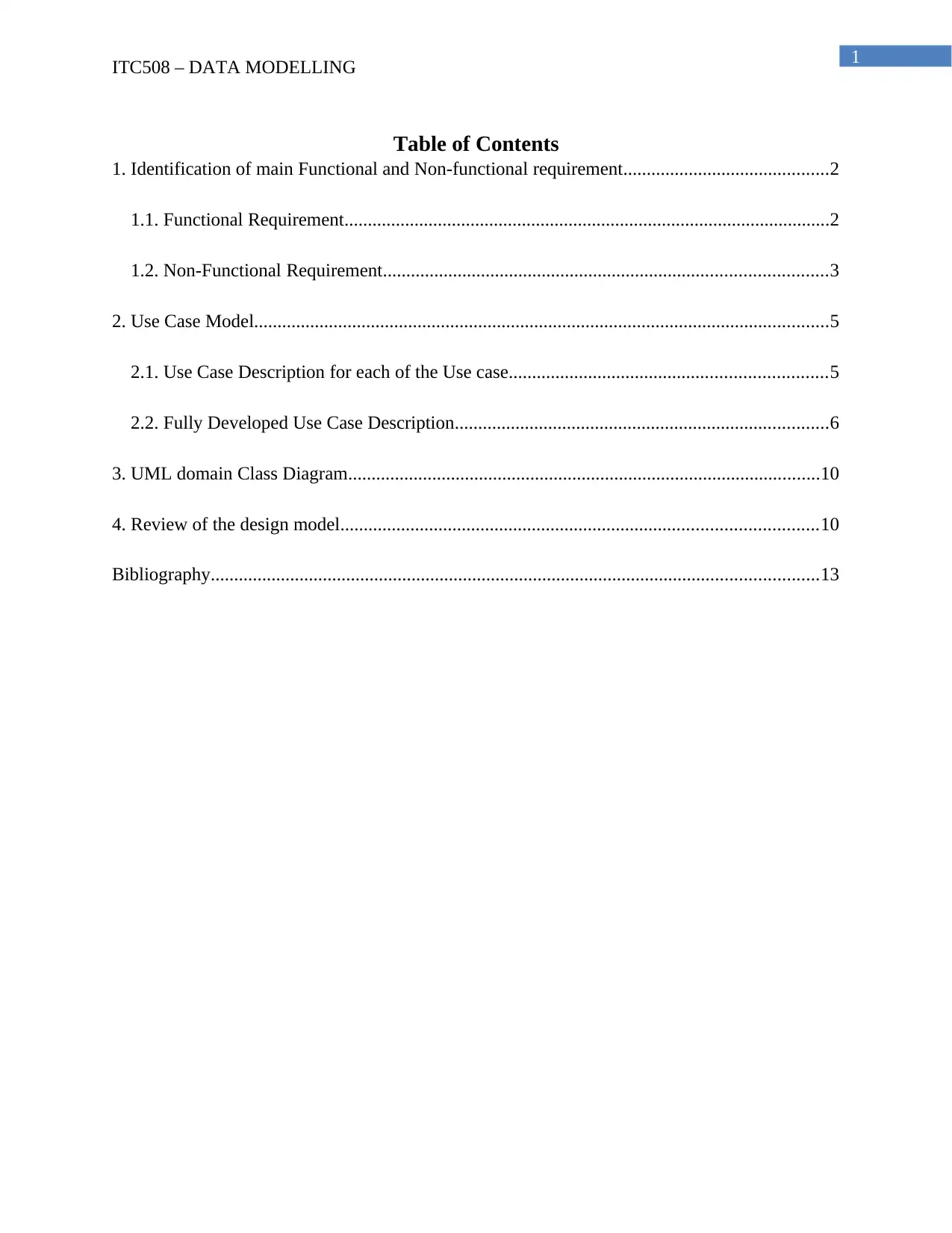
1
ITC508 – DATA MODELLING
Table of Contents
1. Identification of main Functional and Non-functional requirement............................................2
1.1. Functional Requirement........................................................................................................2
1.2. Non-Functional Requirement...............................................................................................3
2. Use Case Model...........................................................................................................................5
2.1. Use Case Description for each of the Use case....................................................................5
2.2. Fully Developed Use Case Description................................................................................6
3. UML domain Class Diagram.....................................................................................................10
4. Review of the design model......................................................................................................10
Bibliography..................................................................................................................................13
ITC508 – DATA MODELLING
Table of Contents
1. Identification of main Functional and Non-functional requirement............................................2
1.1. Functional Requirement........................................................................................................2
1.2. Non-Functional Requirement...............................................................................................3
2. Use Case Model...........................................................................................................................5
2.1. Use Case Description for each of the Use case....................................................................5
2.2. Fully Developed Use Case Description................................................................................6
3. UML domain Class Diagram.....................................................................................................10
4. Review of the design model......................................................................................................10
Bibliography..................................................................................................................................13
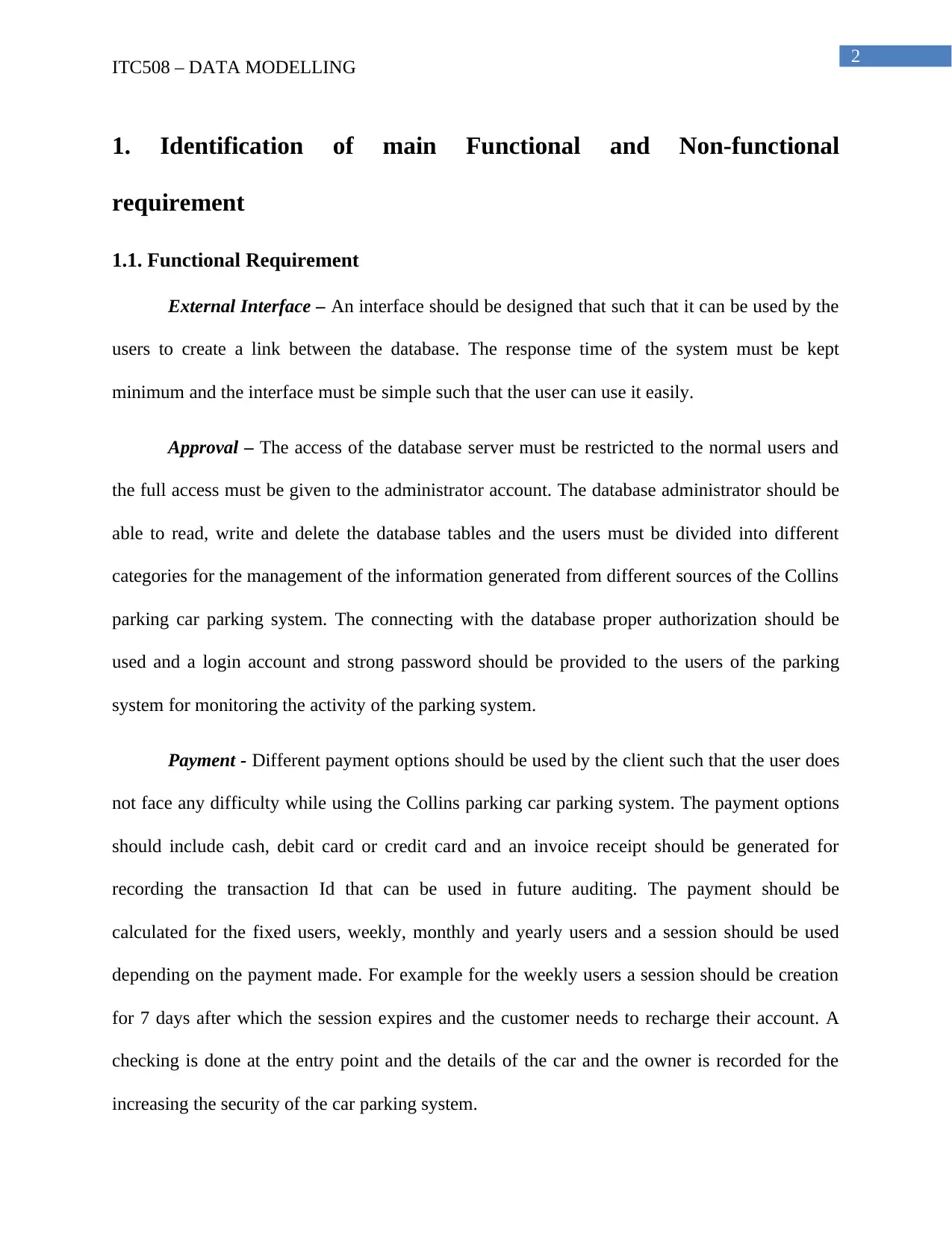
2
ITC508 – DATA MODELLING
1. Identification of main Functional and Non-functional
requirement
1.1. Functional Requirement
External Interface – An interface should be designed that such that it can be used by the
users to create a link between the database. The response time of the system must be kept
minimum and the interface must be simple such that the user can use it easily.
Approval – The access of the database server must be restricted to the normal users and
the full access must be given to the administrator account. The database administrator should be
able to read, write and delete the database tables and the users must be divided into different
categories for the management of the information generated from different sources of the Collins
parking car parking system. The connecting with the database proper authorization should be
used and a login account and strong password should be provided to the users of the parking
system for monitoring the activity of the parking system.
Payment - Different payment options should be used by the client such that the user does
not face any difficulty while using the Collins parking car parking system. The payment options
should include cash, debit card or credit card and an invoice receipt should be generated for
recording the transaction Id that can be used in future auditing. The payment should be
calculated for the fixed users, weekly, monthly and yearly users and a session should be used
depending on the payment made. For example for the weekly users a session should be creation
for 7 days after which the session expires and the customer needs to recharge their account. A
checking is done at the entry point and the details of the car and the owner is recorded for the
increasing the security of the car parking system.
ITC508 – DATA MODELLING
1. Identification of main Functional and Non-functional
requirement
1.1. Functional Requirement
External Interface – An interface should be designed that such that it can be used by the
users to create a link between the database. The response time of the system must be kept
minimum and the interface must be simple such that the user can use it easily.
Approval – The access of the database server must be restricted to the normal users and
the full access must be given to the administrator account. The database administrator should be
able to read, write and delete the database tables and the users must be divided into different
categories for the management of the information generated from different sources of the Collins
parking car parking system. The connecting with the database proper authorization should be
used and a login account and strong password should be provided to the users of the parking
system for monitoring the activity of the parking system.
Payment - Different payment options should be used by the client such that the user does
not face any difficulty while using the Collins parking car parking system. The payment options
should include cash, debit card or credit card and an invoice receipt should be generated for
recording the transaction Id that can be used in future auditing. The payment should be
calculated for the fixed users, weekly, monthly and yearly users and a session should be used
depending on the payment made. For example for the weekly users a session should be creation
for 7 days after which the session expires and the customer needs to recharge their account. A
checking is done at the entry point and the details of the car and the owner is recorded for the
increasing the security of the car parking system.
⊘ This is a preview!⊘
Do you want full access?
Subscribe today to unlock all pages.

Trusted by 1+ million students worldwide
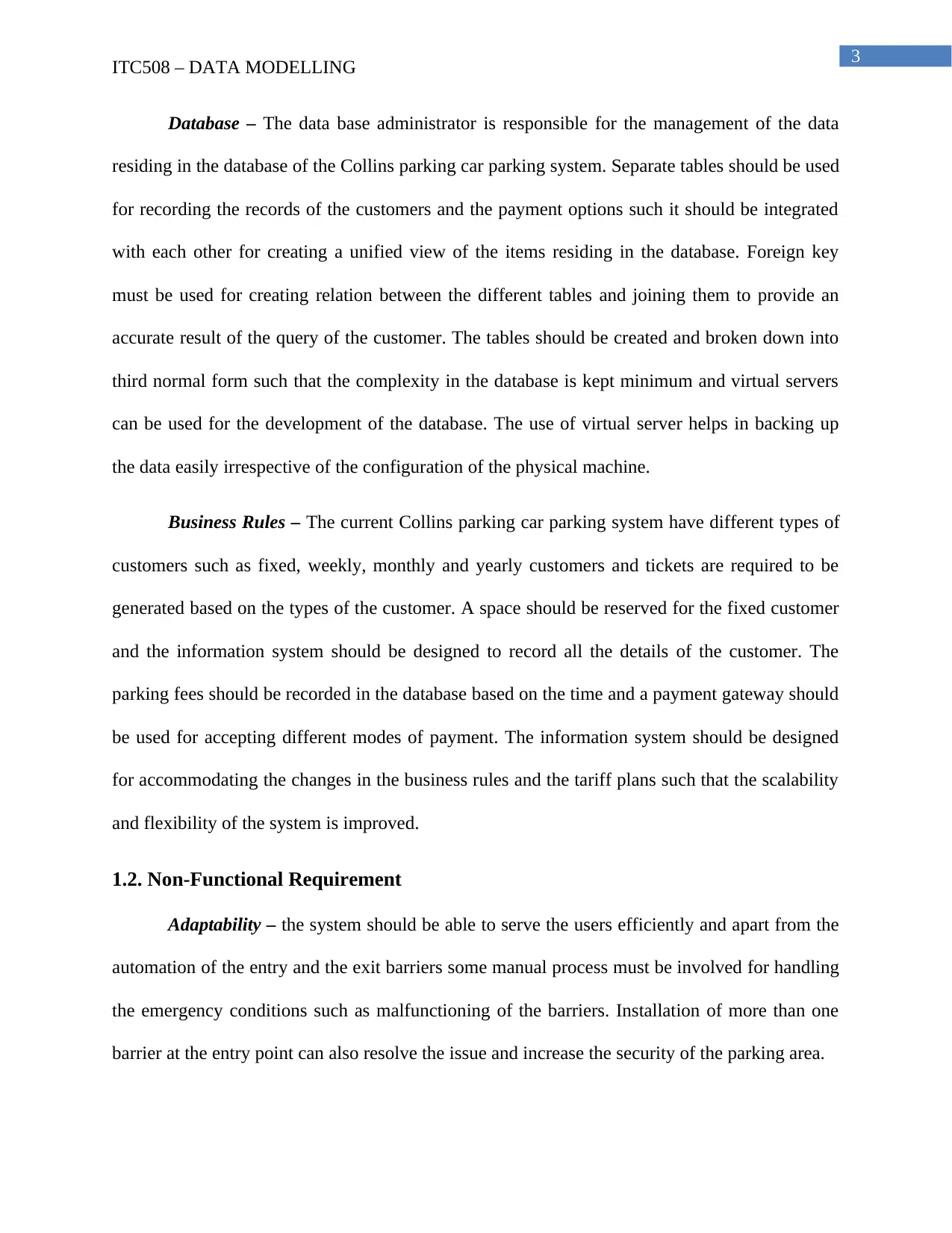
3
ITC508 – DATA MODELLING
Database – The data base administrator is responsible for the management of the data
residing in the database of the Collins parking car parking system. Separate tables should be used
for recording the records of the customers and the payment options such it should be integrated
with each other for creating a unified view of the items residing in the database. Foreign key
must be used for creating relation between the different tables and joining them to provide an
accurate result of the query of the customer. The tables should be created and broken down into
third normal form such that the complexity in the database is kept minimum and virtual servers
can be used for the development of the database. The use of virtual server helps in backing up
the data easily irrespective of the configuration of the physical machine.
Business Rules – The current Collins parking car parking system have different types of
customers such as fixed, weekly, monthly and yearly customers and tickets are required to be
generated based on the types of the customer. A space should be reserved for the fixed customer
and the information system should be designed to record all the details of the customer. The
parking fees should be recorded in the database based on the time and a payment gateway should
be used for accepting different modes of payment. The information system should be designed
for accommodating the changes in the business rules and the tariff plans such that the scalability
and flexibility of the system is improved.
1.2. Non-Functional Requirement
Adaptability – the system should be able to serve the users efficiently and apart from the
automation of the entry and the exit barriers some manual process must be involved for handling
the emergency conditions such as malfunctioning of the barriers. Installation of more than one
barrier at the entry point can also resolve the issue and increase the security of the parking area.
ITC508 – DATA MODELLING
Database – The data base administrator is responsible for the management of the data
residing in the database of the Collins parking car parking system. Separate tables should be used
for recording the records of the customers and the payment options such it should be integrated
with each other for creating a unified view of the items residing in the database. Foreign key
must be used for creating relation between the different tables and joining them to provide an
accurate result of the query of the customer. The tables should be created and broken down into
third normal form such that the complexity in the database is kept minimum and virtual servers
can be used for the development of the database. The use of virtual server helps in backing up
the data easily irrespective of the configuration of the physical machine.
Business Rules – The current Collins parking car parking system have different types of
customers such as fixed, weekly, monthly and yearly customers and tickets are required to be
generated based on the types of the customer. A space should be reserved for the fixed customer
and the information system should be designed to record all the details of the customer. The
parking fees should be recorded in the database based on the time and a payment gateway should
be used for accepting different modes of payment. The information system should be designed
for accommodating the changes in the business rules and the tariff plans such that the scalability
and flexibility of the system is improved.
1.2. Non-Functional Requirement
Adaptability – the system should be able to serve the users efficiently and apart from the
automation of the entry and the exit barriers some manual process must be involved for handling
the emergency conditions such as malfunctioning of the barriers. Installation of more than one
barrier at the entry point can also resolve the issue and increase the security of the parking area.
Paraphrase This Document
Need a fresh take? Get an instant paraphrase of this document with our AI Paraphraser
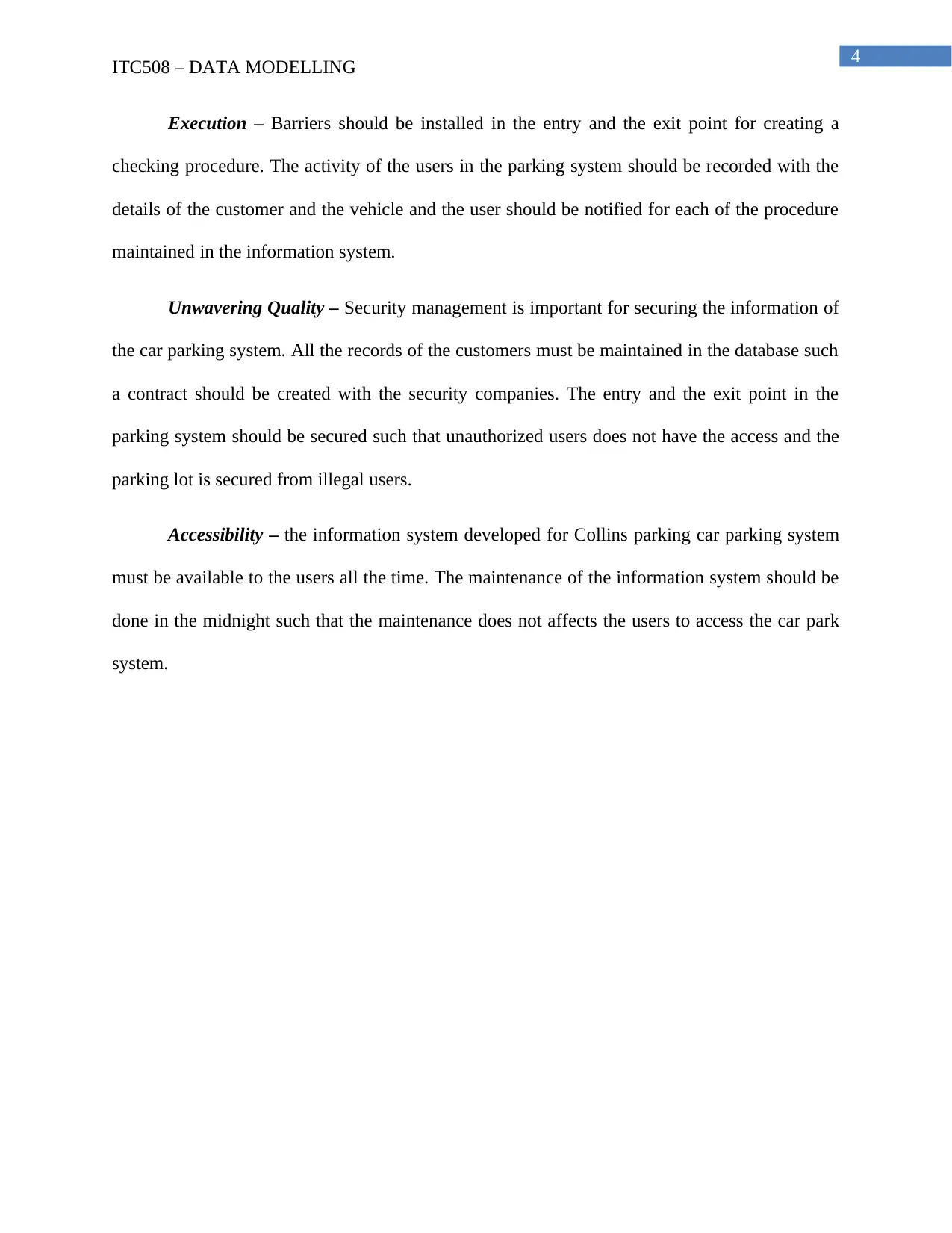
4
ITC508 – DATA MODELLING
Execution – Barriers should be installed in the entry and the exit point for creating a
checking procedure. The activity of the users in the parking system should be recorded with the
details of the customer and the vehicle and the user should be notified for each of the procedure
maintained in the information system.
Unwavering Quality – Security management is important for securing the information of
the car parking system. All the records of the customers must be maintained in the database such
a contract should be created with the security companies. The entry and the exit point in the
parking system should be secured such that unauthorized users does not have the access and the
parking lot is secured from illegal users.
Accessibility – the information system developed for Collins parking car parking system
must be available to the users all the time. The maintenance of the information system should be
done in the midnight such that the maintenance does not affects the users to access the car park
system.
ITC508 – DATA MODELLING
Execution – Barriers should be installed in the entry and the exit point for creating a
checking procedure. The activity of the users in the parking system should be recorded with the
details of the customer and the vehicle and the user should be notified for each of the procedure
maintained in the information system.
Unwavering Quality – Security management is important for securing the information of
the car parking system. All the records of the customers must be maintained in the database such
a contract should be created with the security companies. The entry and the exit point in the
parking system should be secured such that unauthorized users does not have the access and the
parking lot is secured from illegal users.
Accessibility – the information system developed for Collins parking car parking system
must be available to the users all the time. The maintenance of the information system should be
done in the midnight such that the maintenance does not affects the users to access the car park
system.
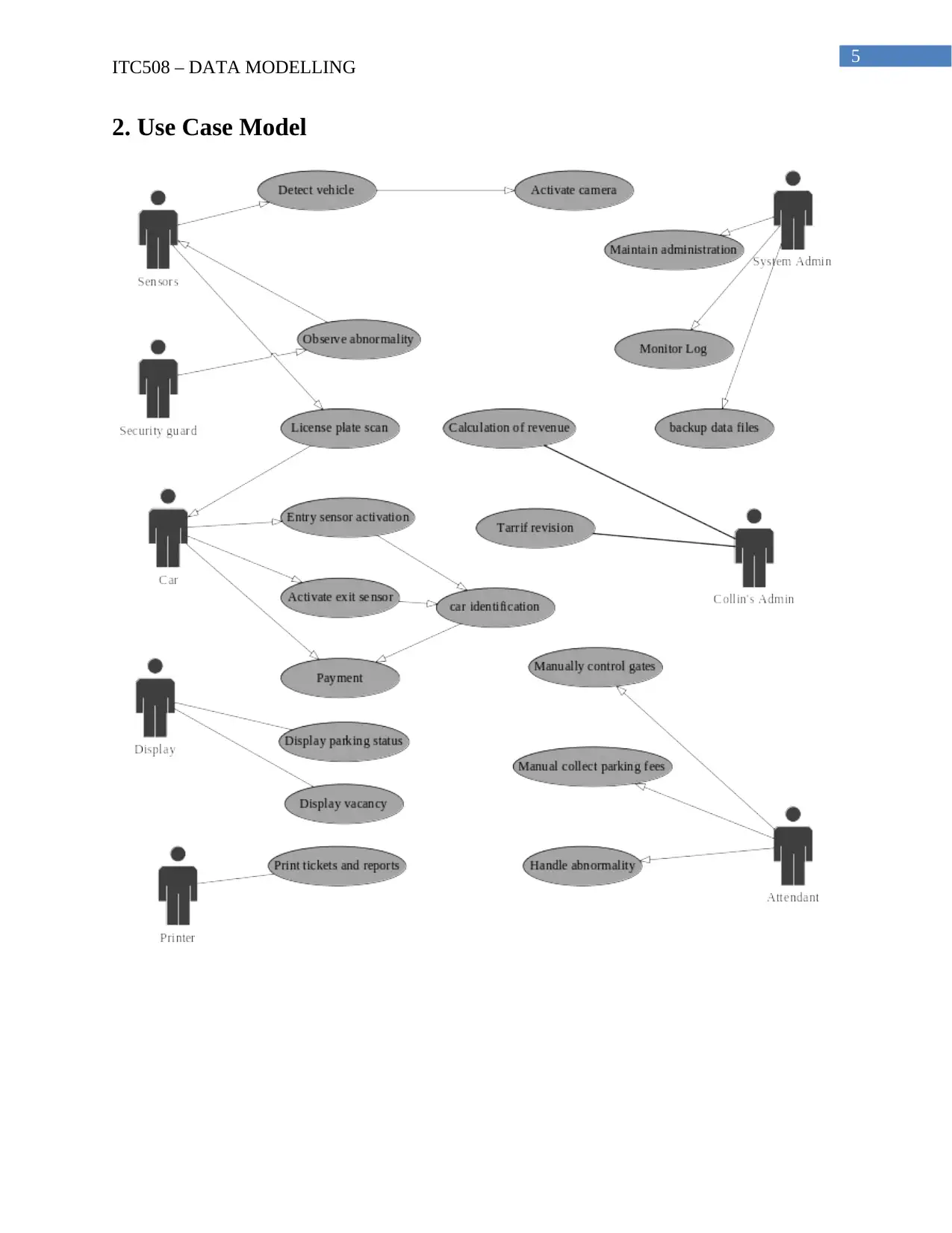
5
ITC508 – DATA MODELLING
2. Use Case Model
ITC508 – DATA MODELLING
2. Use Case Model
⊘ This is a preview!⊘
Do you want full access?
Subscribe today to unlock all pages.

Trusted by 1+ million students worldwide
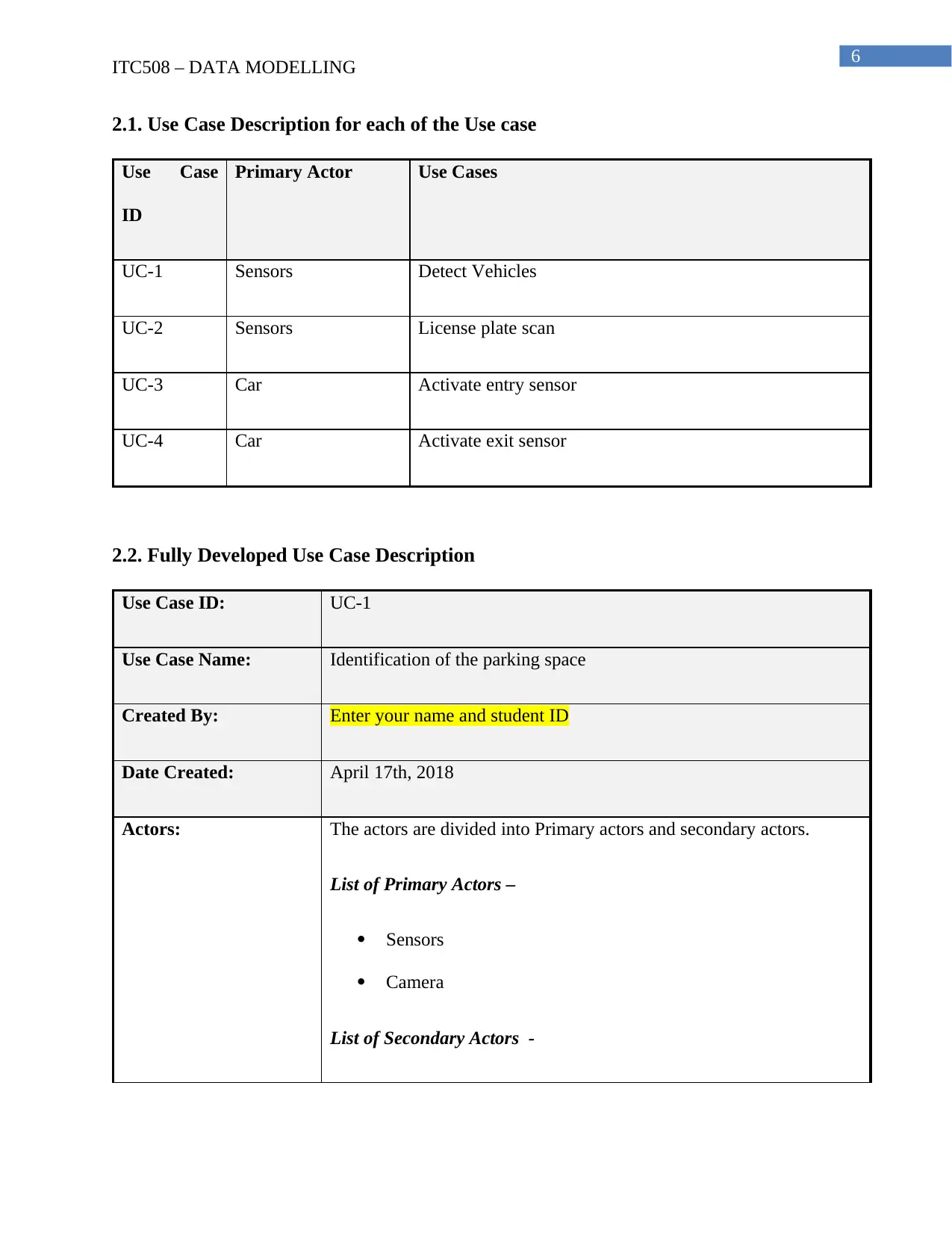
6
ITC508 – DATA MODELLING
2.1. Use Case Description for each of the Use case
Use Case
ID
Primary Actor Use Cases
UC-1 Sensors Detect Vehicles
UC-2 Sensors License plate scan
UC-3 Car Activate entry sensor
UC-4 Car Activate exit sensor
2.2. Fully Developed Use Case Description
Use Case ID: UC-1
Use Case Name: Identification of the parking space
Created By: Enter your name and student ID
Date Created: April 17th, 2018
Actors: The actors are divided into Primary actors and secondary actors.
List of Primary Actors –
Sensors
Camera
List of Secondary Actors -
ITC508 – DATA MODELLING
2.1. Use Case Description for each of the Use case
Use Case
ID
Primary Actor Use Cases
UC-1 Sensors Detect Vehicles
UC-2 Sensors License plate scan
UC-3 Car Activate entry sensor
UC-4 Car Activate exit sensor
2.2. Fully Developed Use Case Description
Use Case ID: UC-1
Use Case Name: Identification of the parking space
Created By: Enter your name and student ID
Date Created: April 17th, 2018
Actors: The actors are divided into Primary actors and secondary actors.
List of Primary Actors –
Sensors
Camera
List of Secondary Actors -
Paraphrase This Document
Need a fresh take? Get an instant paraphrase of this document with our AI Paraphraser
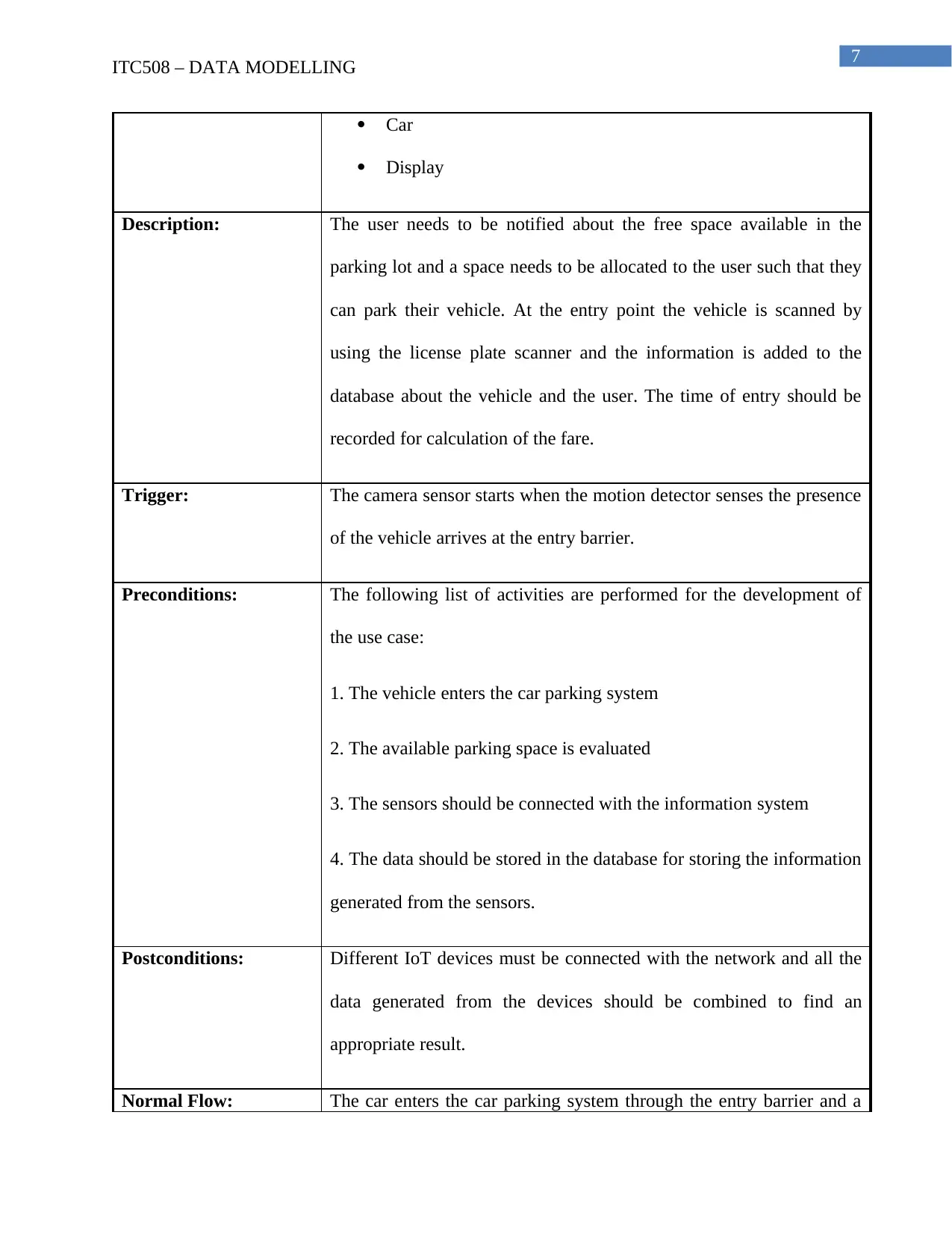
7
ITC508 – DATA MODELLING
Car
Display
Description: The user needs to be notified about the free space available in the
parking lot and a space needs to be allocated to the user such that they
can park their vehicle. At the entry point the vehicle is scanned by
using the license plate scanner and the information is added to the
database about the vehicle and the user. The time of entry should be
recorded for calculation of the fare.
Trigger: The camera sensor starts when the motion detector senses the presence
of the vehicle arrives at the entry barrier.
Preconditions: The following list of activities are performed for the development of
the use case:
1. The vehicle enters the car parking system
2. The available parking space is evaluated
3. The sensors should be connected with the information system
4. The data should be stored in the database for storing the information
generated from the sensors.
Postconditions: Different IoT devices must be connected with the network and all the
data generated from the devices should be combined to find an
appropriate result.
Normal Flow: The car enters the car parking system through the entry barrier and a
ITC508 – DATA MODELLING
Car
Display
Description: The user needs to be notified about the free space available in the
parking lot and a space needs to be allocated to the user such that they
can park their vehicle. At the entry point the vehicle is scanned by
using the license plate scanner and the information is added to the
database about the vehicle and the user. The time of entry should be
recorded for calculation of the fare.
Trigger: The camera sensor starts when the motion detector senses the presence
of the vehicle arrives at the entry barrier.
Preconditions: The following list of activities are performed for the development of
the use case:
1. The vehicle enters the car parking system
2. The available parking space is evaluated
3. The sensors should be connected with the information system
4. The data should be stored in the database for storing the information
generated from the sensors.
Postconditions: Different IoT devices must be connected with the network and all the
data generated from the devices should be combined to find an
appropriate result.
Normal Flow: The car enters the car parking system through the entry barrier and a
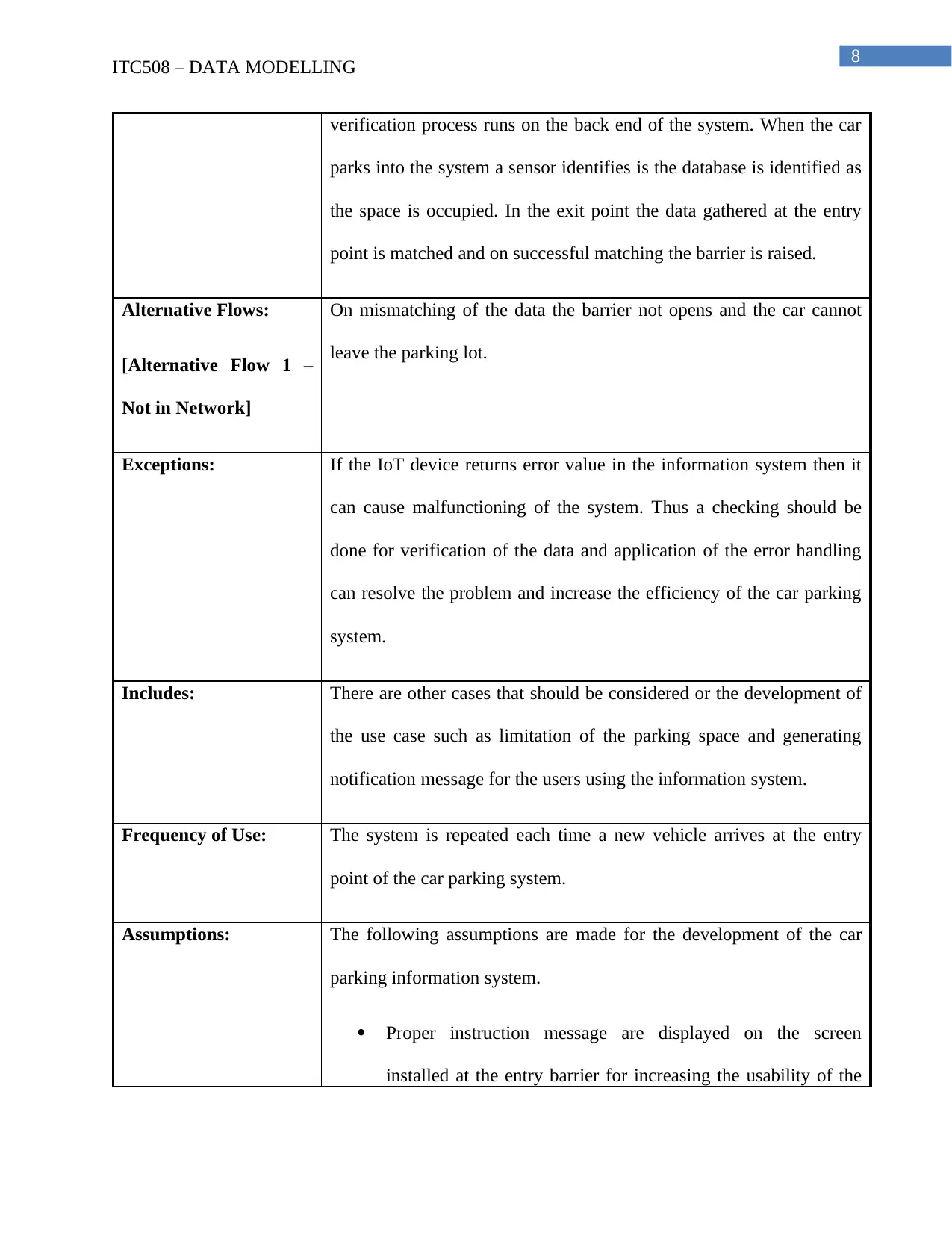
8
ITC508 – DATA MODELLING
verification process runs on the back end of the system. When the car
parks into the system a sensor identifies is the database is identified as
the space is occupied. In the exit point the data gathered at the entry
point is matched and on successful matching the barrier is raised.
Alternative Flows:
[Alternative Flow 1 –
Not in Network]
On mismatching of the data the barrier not opens and the car cannot
leave the parking lot.
Exceptions: If the IoT device returns error value in the information system then it
can cause malfunctioning of the system. Thus a checking should be
done for verification of the data and application of the error handling
can resolve the problem and increase the efficiency of the car parking
system.
Includes: There are other cases that should be considered or the development of
the use case such as limitation of the parking space and generating
notification message for the users using the information system.
Frequency of Use: The system is repeated each time a new vehicle arrives at the entry
point of the car parking system.
Assumptions: The following assumptions are made for the development of the car
parking information system.
Proper instruction message are displayed on the screen
installed at the entry barrier for increasing the usability of the
ITC508 – DATA MODELLING
verification process runs on the back end of the system. When the car
parks into the system a sensor identifies is the database is identified as
the space is occupied. In the exit point the data gathered at the entry
point is matched and on successful matching the barrier is raised.
Alternative Flows:
[Alternative Flow 1 –
Not in Network]
On mismatching of the data the barrier not opens and the car cannot
leave the parking lot.
Exceptions: If the IoT device returns error value in the information system then it
can cause malfunctioning of the system. Thus a checking should be
done for verification of the data and application of the error handling
can resolve the problem and increase the efficiency of the car parking
system.
Includes: There are other cases that should be considered or the development of
the use case such as limitation of the parking space and generating
notification message for the users using the information system.
Frequency of Use: The system is repeated each time a new vehicle arrives at the entry
point of the car parking system.
Assumptions: The following assumptions are made for the development of the car
parking information system.
Proper instruction message are displayed on the screen
installed at the entry barrier for increasing the usability of the
⊘ This is a preview!⊘
Do you want full access?
Subscribe today to unlock all pages.

Trusted by 1+ million students worldwide
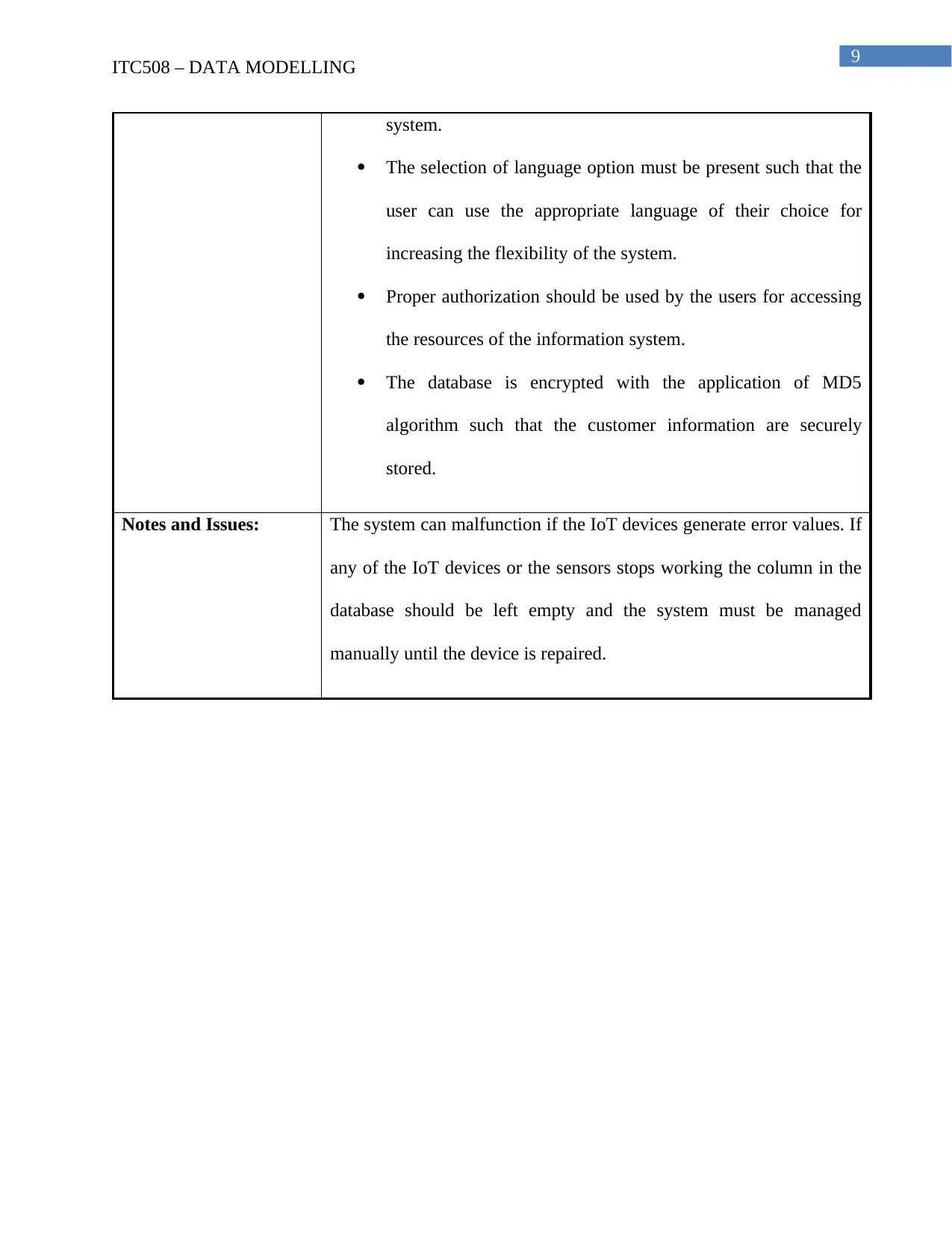
9
ITC508 – DATA MODELLING
system.
The selection of language option must be present such that the
user can use the appropriate language of their choice for
increasing the flexibility of the system.
Proper authorization should be used by the users for accessing
the resources of the information system.
The database is encrypted with the application of MD5
algorithm such that the customer information are securely
stored.
Notes and Issues: The system can malfunction if the IoT devices generate error values. If
any of the IoT devices or the sensors stops working the column in the
database should be left empty and the system must be managed
manually until the device is repaired.
ITC508 – DATA MODELLING
system.
The selection of language option must be present such that the
user can use the appropriate language of their choice for
increasing the flexibility of the system.
Proper authorization should be used by the users for accessing
the resources of the information system.
The database is encrypted with the application of MD5
algorithm such that the customer information are securely
stored.
Notes and Issues: The system can malfunction if the IoT devices generate error values. If
any of the IoT devices or the sensors stops working the column in the
database should be left empty and the system must be managed
manually until the device is repaired.
Paraphrase This Document
Need a fresh take? Get an instant paraphrase of this document with our AI Paraphraser
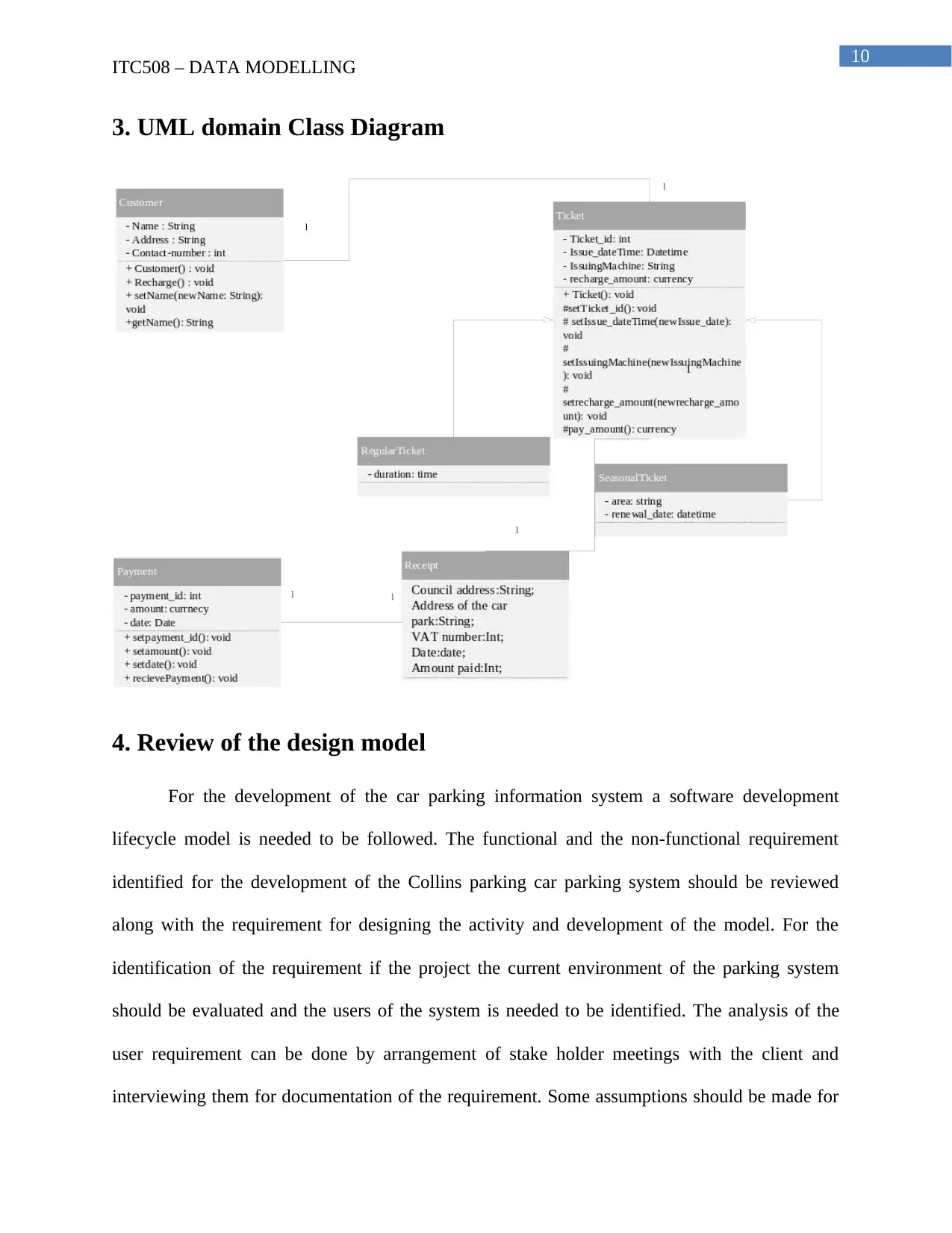
10
ITC508 – DATA MODELLING
3. UML domain Class Diagram
4. Review of the design model
For the development of the car parking information system a software development
lifecycle model is needed to be followed. The functional and the non-functional requirement
identified for the development of the Collins parking car parking system should be reviewed
along with the requirement for designing the activity and development of the model. For the
identification of the requirement if the project the current environment of the parking system
should be evaluated and the users of the system is needed to be identified. The analysis of the
user requirement can be done by arrangement of stake holder meetings with the client and
interviewing them for documentation of the requirement. Some assumptions should be made for
ITC508 – DATA MODELLING
3. UML domain Class Diagram
4. Review of the design model
For the development of the car parking information system a software development
lifecycle model is needed to be followed. The functional and the non-functional requirement
identified for the development of the Collins parking car parking system should be reviewed
along with the requirement for designing the activity and development of the model. For the
identification of the requirement if the project the current environment of the parking system
should be evaluated and the users of the system is needed to be identified. The analysis of the
user requirement can be done by arrangement of stake holder meetings with the client and
interviewing them for documentation of the requirement. Some assumptions should be made for
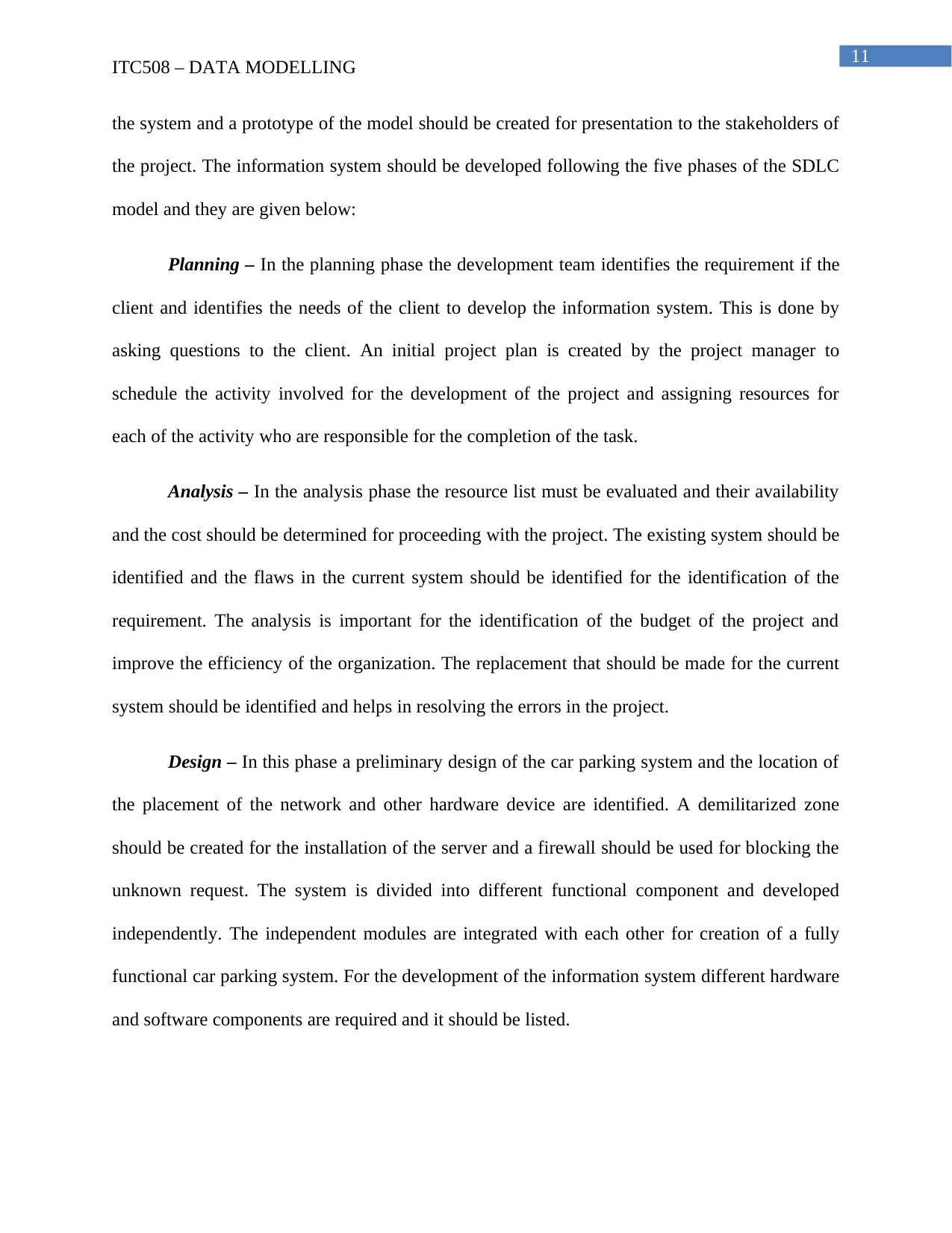
11
ITC508 – DATA MODELLING
the system and a prototype of the model should be created for presentation to the stakeholders of
the project. The information system should be developed following the five phases of the SDLC
model and they are given below:
Planning – In the planning phase the development team identifies the requirement if the
client and identifies the needs of the client to develop the information system. This is done by
asking questions to the client. An initial project plan is created by the project manager to
schedule the activity involved for the development of the project and assigning resources for
each of the activity who are responsible for the completion of the task.
Analysis – In the analysis phase the resource list must be evaluated and their availability
and the cost should be determined for proceeding with the project. The existing system should be
identified and the flaws in the current system should be identified for the identification of the
requirement. The analysis is important for the identification of the budget of the project and
improve the efficiency of the organization. The replacement that should be made for the current
system should be identified and helps in resolving the errors in the project.
Design – In this phase a preliminary design of the car parking system and the location of
the placement of the network and other hardware device are identified. A demilitarized zone
should be created for the installation of the server and a firewall should be used for blocking the
unknown request. The system is divided into different functional component and developed
independently. The independent modules are integrated with each other for creation of a fully
functional car parking system. For the development of the information system different hardware
and software components are required and it should be listed.
ITC508 – DATA MODELLING
the system and a prototype of the model should be created for presentation to the stakeholders of
the project. The information system should be developed following the five phases of the SDLC
model and they are given below:
Planning – In the planning phase the development team identifies the requirement if the
client and identifies the needs of the client to develop the information system. This is done by
asking questions to the client. An initial project plan is created by the project manager to
schedule the activity involved for the development of the project and assigning resources for
each of the activity who are responsible for the completion of the task.
Analysis – In the analysis phase the resource list must be evaluated and their availability
and the cost should be determined for proceeding with the project. The existing system should be
identified and the flaws in the current system should be identified for the identification of the
requirement. The analysis is important for the identification of the budget of the project and
improve the efficiency of the organization. The replacement that should be made for the current
system should be identified and helps in resolving the errors in the project.
Design – In this phase a preliminary design of the car parking system and the location of
the placement of the network and other hardware device are identified. A demilitarized zone
should be created for the installation of the server and a firewall should be used for blocking the
unknown request. The system is divided into different functional component and developed
independently. The independent modules are integrated with each other for creation of a fully
functional car parking system. For the development of the information system different hardware
and software components are required and it should be listed.
⊘ This is a preview!⊘
Do you want full access?
Subscribe today to unlock all pages.

Trusted by 1+ million students worldwide
1 out of 15
Related Documents
Your All-in-One AI-Powered Toolkit for Academic Success.
+13062052269
info@desklib.com
Available 24*7 on WhatsApp / Email
![[object Object]](/_next/static/media/star-bottom.7253800d.svg)
Unlock your academic potential
Copyright © 2020–2025 A2Z Services. All Rights Reserved. Developed and managed by ZUCOL.



